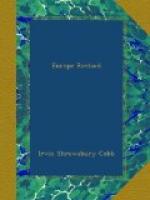They still have him, or what is left of him, in that glass case. He did not exactly suffer martyrdom—though probably he personally did not notice any very great difference—and so he has not been canonized; nevertheless, they have him there in that church. In all Europe I only saw one sight to match him, and that was down in the crypt under the Church of the Capuchins, in Rome, where the dissected cadavers of four thousand dead—but not gone—monks are worked up into decorations. There are altars made of their skulls, and chandeliers made of their thigh bones; frescoes of their spines; mosaics of their teeth and dried muscles; cozy corners of their femurs and pelves and tibiae. There are two classes of travelers I would strongly advise not to visit the crypt of the Capuchins’ Church—those who are just about to have dinner and want to have it, and those who have just had dinner and want to keep on having it.
At the royal palace in Vienna we saw the finest, largest, and gaudiest collection of crown jewels extant. That guide of ours seemed to think he had done his whole duty toward us and could call it a day and knock off when he led us up to the jewel collections, where each case was surrounded by pop-eyed American tourists taking on flesh at the sight of all those sparklers and figuring up the grand total of their valuation in dollars, on the basis of so many hundreds of carats at so many hundred dollars a carat, until reason tottered on her throne—and did not have so very far to totter, either.
The display or all those gems, however, did not especially excite me. There were too many of them and they were too large. A blue Kimberley in a hotel clerk’s shirtfront or a pigeonblood ruby on a faro dealer’s little finger might hold my attention and win my admiration; but where jewels are piled up in heaps like anthracite in a coal bin they thrill me no more than the anthracite would. A quart measure of diamonds of the average size of a big hailstone does not make me think of diamonds but of hailstones. I could remain as calm in their presence as I should in the presence of a quart of cracked ice; in fact, calmer than I should remain in the presence of a quart of cracked ice in Italy, say, where there is not that much ice, cracked or otherwise. In Italy a bucketful of ice would be worth traveling miles to see. You could sell tickets for it.
In one of the smaller rooms of the palace we came on a casket containing a necklace of great smoldering rubies and a pair of bracelets to match. They were as big as cranberries and as red as blood—as red as arterial blood. And when, on consulting the guidebook, we read the history of those rubies the sight of them brought a picture to our minds, for they had been a part of the wedding dowry of Marie Antoinette. Once on a time this necklace had spanned the slender white throat that was later to be sheared by the guillotine, and these bracelets had clasped the same white wrists that were roped together with an ell of hangman’s hemp on the day the desolated queen rode, in her patched and shabby gown, to the Place de la Revolution.




